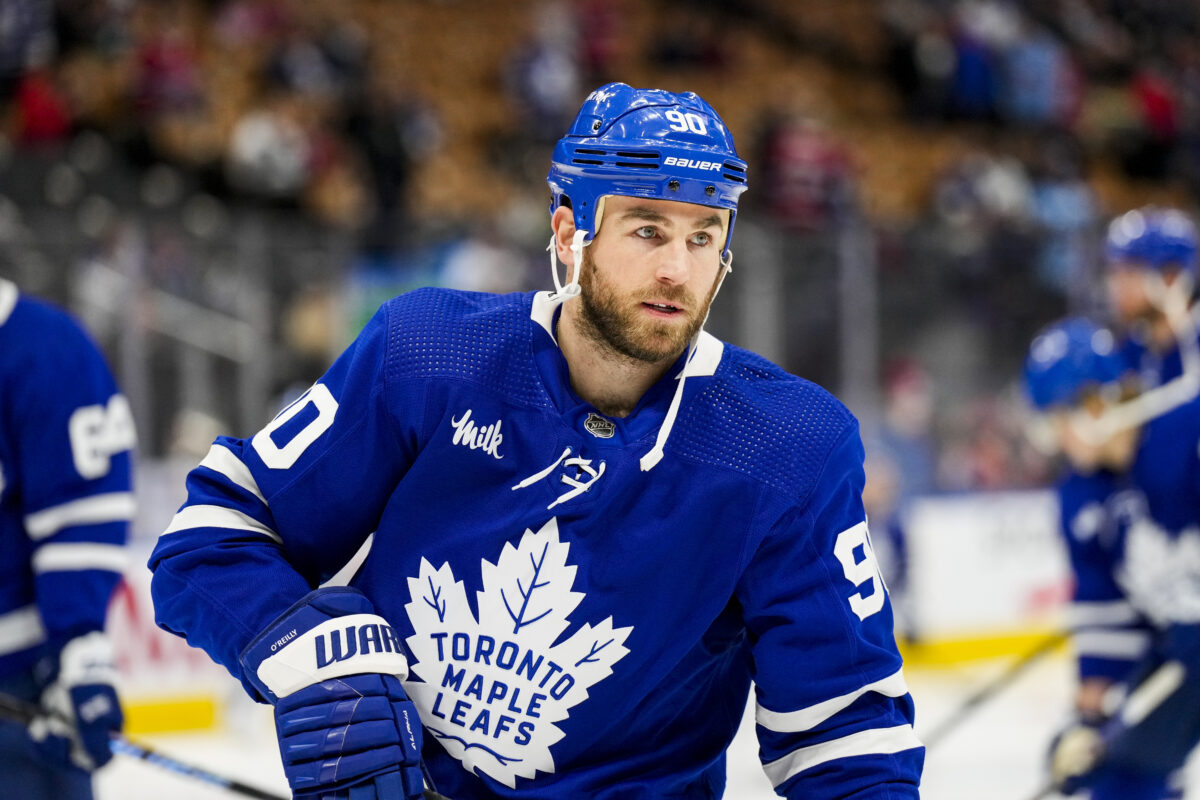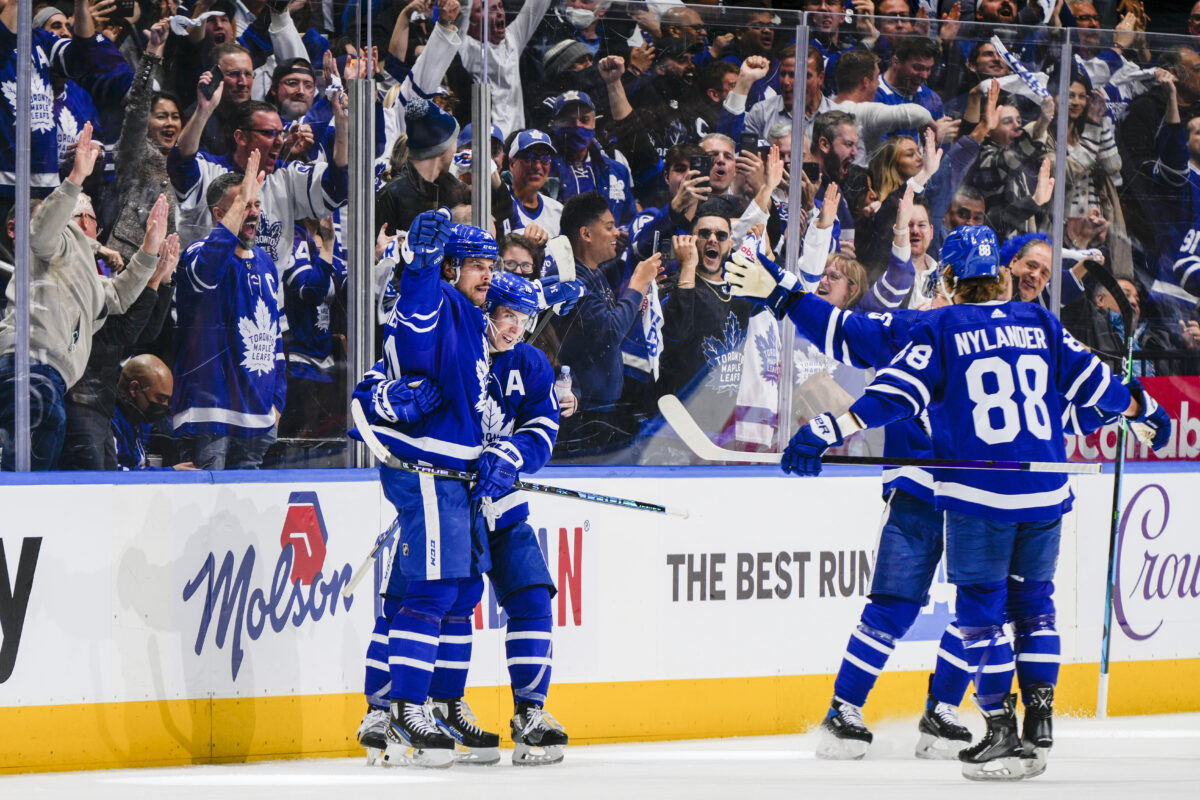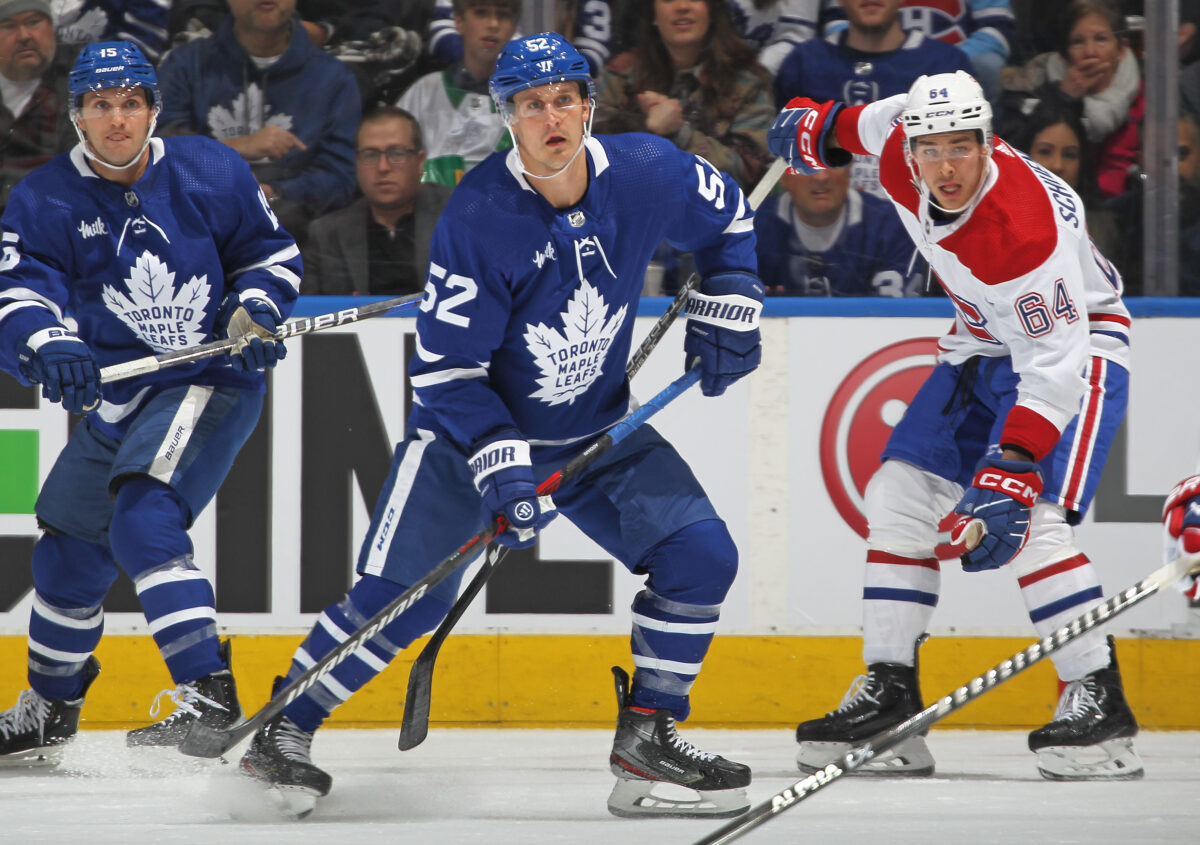On Saturday morning, the hockey world woke up to find out that, while we were asleep, Toronto Maple Leafs general manager Kyle Dubas was busy putting together a blockbuster move that added two solid pieces to his roster. Even better, he didn’t give up a single player on the roster and kept the team under the $82.5 million salary-cap maximum.
Here is the deal according to CapFriendly: The Maple Leafs get forward Ryan O’Reilly (50% retained from Minnesota Wild (75% retained in total), forward Noel Acciari, and forward Josh Pillar. The Blues get forward Mikhail Abramov, forward Adam Gaudette, a 2023 first-round pick from Toronto, a 2023 third-round pick from the Ottawa Senators, and a 2024 second-round pick from Toronto. The Wild get a 2025 fourth-round pick from Toronto.
Looking past all the moving parts of this deal and getting down to what it means for the Maple Leafs on the ice, they acquired a former Conn Smythe winner in Ryan O’Reilly, with a $7.5 million salary, for a salary-cap hit of only $1.875 million. As a bonus, they also added a physical (933 hits in 361 games) bottom-six center/winger in Noel Acciari, who comes with a salary-cap hit of $1.25 million.
Since the trade, much has been made about O’Reilly’s 2022-23 season in St. Louis. In this post, we want to take a deeper dive into his “poor” season.
The Maple Leafs Are Engaging in High Risk, High Reward
This trade is definitely one of those “risk/reward” situations. The risk is that the 32-year-old O’Reilly is exactly what his “down” season suggests. As well, there’s an additional risk because he’s coming off six weeks spent on long-term injury reserve (LTIR) with a broken foot.
O’Reilly comes with questions. Can he stay healthy? Can he return to the form he had when he led the Blues to the Stanley Cup in 2019?
Related: Alexander Mogilny: The Great Russian Enigma
With all the different stats that are tracked these days, there are a number of ways to gain further insight into this particular trade. If we look at old-fashioned production numbers, O’Reilly’s per-game goal production is actually up from last season. He has scored 12 goals in 40 games, which is a 25-goal, 82-game pace. That compares favorably to his 21 goals in 78 games last season.
What is down drastically this season are O’Reilly’s assists. He has just seven assists in 40 games, an 82-game pace of just 14. That compares with 37 assists last season.
That brings us to the question, has O’Reilly, who has been known in his career as much as a puck distributor as a goal scorer, struggled in his playmaking this season? Or, have the players around him struggled to finish?
Seeking Insight About O’Reilly Using the Statistic PDO
In an effort to get an answer to the two questions above, we can jump over to some underlying numbers for O’Reilly. There is a stat called PDO. A strange thing about PDO is that the initials don’t appear to be an acronym or stand for anything. What it does measure and represent is “luck.”
PDO is a combination of a team’s shooting percentage and save percentage when a certain player is on the ice. The average PDO for the league is considered to be 100%. Anything over that is considered to be a positive (good luck), and anything under is considered a negative (or bad luck).

When we looked for something to gain better insight into O’Reilly’s statistics, we came across this note. According to the website Statmuse.com the shooting percentage of the entire league in 2022-23 is 9.9%. The average save percentage this season is 90.1%. If we add those two percentages together, 9.9% + 90.1% = 100%.
Related: With Ryan O’Reilly Maple Leafs Bring In Postseason Success
Getting back to O’Reilly, in his previous four seasons with the Blues, his average PDO was 102.4%. This season his PDO is a lowly 92.6%. It’s down almost a full 10% from his four-year average.
O’Reilly’s average on-ice shooting percentage over the past four seasons has been 12.4%. His average on-ice save percentage over the past four seasons was 90%. This season his on-ice shooting percentage is 9.0%, down 3.4% from his four-year average. His on-ice save percentage this season is 83.6%, down 6.4% from his four-year average.
O’Reilly’s Statistics Suggest Teammates Were Underperforming
Putting that all together we get a player who is still scoring goals at the same rate he has in previous seasons. However, his assist production is way down. A deeper dive shows that his team’s shooting percentage and save percentage when he’s on the ice have taken a drastic drop this season. That could explain the massive drop in his assists. The players around him are not performing at the same level they have in the past.
If O’Reilly gets to spend time on a line with any two of Auston Matthews, Mitch Marner, William Nylander, or John Tavares, we don’t believe his linemates’ failure to score will be a problem.
Related: Maple Leafs News & Rumors: Bedard, Minten, Knies & Tavares
One other thing that jumps off the stats sheet is the fact that the 6-foot-1, 205-pound O’Reilly always seems to be in the conversation for both the Selke Trophy, awarded to the league’s best defensive forward, as well as the Lady Byng Trophy, given out to the player that combines “a high standard of playing ability with gentlemanly conduct.” What that combination of awards says is that O’Reilly is a defensively responsible, 200-foot player who takes few penalties.
Playoffs Versus Regular Season
Much has been made in the last half of a decade about the Maple Leafs’ failure in the playoffs. It’s not news that, despite making the playoffs the past six seasons, the Maple Leafs have yet to get past the first round.
Before O’Reilly was acquired, the top career goal scorer in the playoffs on the Maple Leafs was Tavares, with 18 goals in 44 games. Second was Matthews with 17 goals in 39 games. The top point producers were Tavares (36 points), Matthews (33 points), and Marner (33 points).

Today their top goal scorer in the playoffs is O’Reilly, with 22 goals in 64 games. Ditto with points. He has 56 points in 64 playoff games. His 0.875 points per game in the playoffs also top both Matthews’ and Marner’s (0.846), and Tavares’ (0.818).
Noel Acciari Is a Bonus
Dubas not only acquired a former Conn Smythe winner in O’Reilly but he also bolstered the bottom six with the acquisition of Noel Acciari.
Related: Maple Leafs News & Rumors: Campbell, Worst Trade, Nylander & Marchment
Despite his lack of size, at 5-foot-10, Acciari is a solid 210 pounds. As we mentioned earlier, he does not shy away from the physical aspects of the game, having recorded 933 hits in 378 regular season games played. With 10 goals this season, he also becomes the second-highest scoring player on the Maple Leafs’ bottom six with 10 goals in 55 games played. He’s one goal shy of the Maple Leafs’ top bottom-six goal scorer, Pierre Engvall (12 goals in 54 games).
The right-handed Acciari can play both center and wing. As a centre this season, he has won 53.5% of his faceoffs.
Did someone mention playoffs? In Acciari, the Maple Leafs picked up a player with 54 games of playoff experience with both the Boston Bruins and the Florida Panthers. He only produced three goals and seven points in those 54 games, but still averaged 12:46 of ice time.

His physicality also carries over to the postseason. Acciari has recorded 203 hits in the playoffs.
Not a Bad Trade Pointing to the Postseason
In O’Reilly, the Maple Leafs gained an impact player who was a difference-maker when he hoisted the Stanley Cup three years ago. If they decide to load up the top two lines, he is a proven goal scorer and playmaker who should complement whoever he lines up alongside. If the Maple Leafs want to balance their lineup, he would become a third-line center who could be a first-line center on just about every other team in the league.
Related: Maple Leafs Are Predictable in Their Unpredictability
In Acciari, Dubas acquired a physical, defensively-responsible, bottom-six player who can center either of the bottom two lines or slide over to the right wing.
This deal gives the Maple Leafs one of the best compliments of forwards in the league. I think most Maple Leafs’ fans would be happy if Dubas were done dealing and went into the postseason with this lineup. However, it’s entirely possible that he might not be finished making moves.
You may also like:
- Maple Leafs Won’t Go Far with Samsonov in Net
- Maple Leafs News & Rumors: Marchand, Domi, Samsonov & Nylander
- Maple Leafs in 2-1 Hole to Bruins After Game 3 Loss
- Maple Leafs Test William Nylander for Concussion Concern
- Prime Video to Carry National Monday Night Games in Canada
If Dubas felt he could bolster the defense, he still could still create additional cap space by including players such as upcoming unrestricted free agents Alex Kerfoot, Pierre Engvall, or Justin Holl. Either way, this is a much better team today than it was earlier this week.
[Note: I want to thank long-time Maple Leafs’ fan Stan Smith for collaborating with me on this post. Stan’s Facebook profile can be found here.]